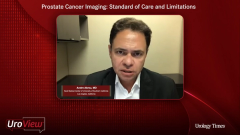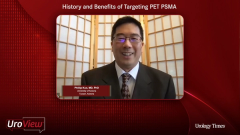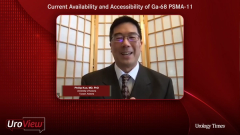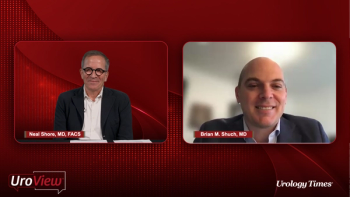
Prostate Cancer Imaging: Standard of Care and Limitations
Andre Abreu, MD, and Phillip Kuo, MD, PhD, define the standard of care and the limitations in prostate cancer imaging.
Episodes in this series

Phillip Kuo, MD, PhD: Hello and welcome to this Uro View video series titled, “Gallium-68 PSMA Targeted PET Imaging in Prostate Cancer: Staging and Outcomes.” My name is Phillip Kuo. I am a professor of medical imaging, medicine, and biomedical engineering at The University of Arizona in Tucson. I’m very honored to be joined today by my colleague Dr Andre Abreu, a urology surgeon at the Keck Medical Center of the University of Southern California in Los Angeles, California. In today’s discussion, we will discuss the role of gallium-68 PSMA [prostate-specific membrane antigen]-targeted PET [positron emission tomography] imaging, its impact on staging, outcomes, and its role specifically when treating prostate cancer. Let’s get started. For the lead off question, I’d like to ask Dr Abreu, what are your feelings about the standard of care for prostate cancer imaging?
Andre Abreu, MD: Thank you for the invitation. It is a pleasure to be here with Professor Kuo. The current [types of] imaging we have for prostate cancer are mostly conventional images, such as MRI scans, CT scans, ultrasounds, and bone scans. As we know, ultrasound imaging for prostate cancer is very limited in terms of staging or even for identifying suspicious lesions within the prostate. Lately we have MRIs; the MRIs improved and changed the way we see localized disease for prostate cancer. An MRI is very useful for the T [tumor] stage, for evaluation of localized advanced disease, and to identify lesions for diagnosis. However, the MRI is very limited in terms of nodal staging or detecting metastases. This also applies to CT scans that would be used for staging of the nodes and metastases. However, CT scans are also limited, and so are the conventional bone scans. There is a need for better imaging modality that would allow us to have a better assessment, evaluation, and risk stratification of patients with prostate cancer.
Phillip Kuo, MD, PhD: Thank you Dr Abreu. I am going to discuss now some of the limitations of the conventional imaging, which you have already touched upon very well. I completely agree with you; particularly for the T staging, the local disease, MRI has made some great advancements. There is high-resolution imaging we do now of the primary prostate gland. We also have an improved ability to evaluate for local invasion into tissues and adjacent seminal vesicles. I couldn’t agree with you more, however, that when it comes to the nodal disease assessment, CT and MRI are still primarily structural modalities, and hence both have the inherent limitations. Just because a lymph node does not reach a certain size criteria does not mean that there is no cancer in there. We can try some other techniques, for example diffusion-weighted imaging or enhancement with contrast, whether it be iodinated contrast on a CT or gadolinium-based contrast agents with an MRI.
Still, it is primarily a structural modality, which still leaves much to be desired, as the studies show, of course. As you mentioned, nuclear medicine has played a big role in prostate cancer assessment for a long time, primarily through bone scans, but even that has some limitations. Of course, it assesses just the bones, as one might imagine from the name, but even the agent, technetium-99m methylene diphosphonate, depends on the reaction of the tumor with the bones. You are not even imaging the tumor or the cancer directly. It is the reaction of the bone to the tumor. We still have a lot of limitations with conventional imaging. There are a lot of things we need to improve on. And as we will touch upon this later in the talk, we may have some one-stop shopping, if you will, with these newer agents that are coming out for PET scans. These will allow us to still assess the entire body like we do with a nuclear medicine bone scan, which is the entire skeleton. But now, it will allow us to evaluate soft tissue and bone all in one go.
Transcript edited for clarity.
Newsletter
Stay current with the latest urology news and practice-changing insights — sign up now for the essential updates every urologist needs.






















